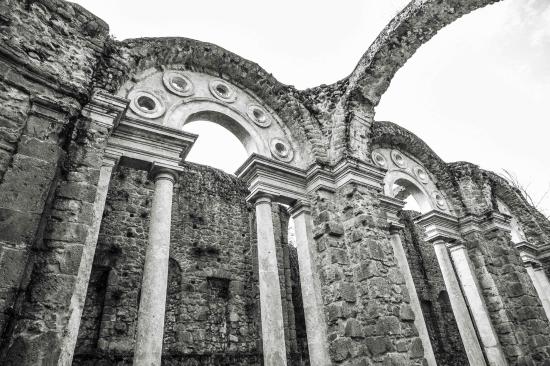Soil structure interaction
The collapse of the Nymphaeum of Genazzano after soil erosion
The Ninfeo of Genazzano is a sixteenth century structure attributed to Bramante and located about 60 km South-East of Rome. The structure, about 46 meters wide, is bordered to the North with a slope. The facade has a central loggia with three spans that finish, on the short sides, in two exedras adjacent to two square rooms. Three serlianas separate the loggia and a space located westward at a higher elevation, which is the proper Ninfeo. The masonry structure of the Ninfeo is made up of several blocks of tuff, lime mortar and pozzolan, with horizontal joints not perfectly regular, inner core of rubble and corner bricks of travertine.
Since the early 19th century the Ninfeo appears in ruins, probably due to the erosion exerted by the stream flowing upon the entire East front of the Ninfeo. In fact, the major instabilities suffered by the construction are concentrated near the original riverbed. Such a mechanism might have caused the partial loss of stability of the vaults system and the consequent rotation of the columns. This is the reason why during the first restoration work, the key intervention was concentrated on the small stream by changing its route and filling its former bed with made ground. The monument stability was likely to be also influenced by the thrust exerted by the slope at its back.
During the last restoration work of the Ninfeo, occurred in 2006, some on-site investigationS and laboratory tests were carried out to characterize the foundation soils.
The hydraulic conditions indicate a position of the water level 1 m below ground level and this elevation coincides with the water level in the tank situated in the octagonal room of the Ninfeo.
The full interaction analysis was performed by a Geotechnical finite element software called Plaxis 3D. This program requires to define the geometry of the problem and generate its mesh within AutoCad code and then switching to the Plaxis code to import the volume, generate its mesh and lastly to execute the analysis in a non-linear field.
The behavior of masonry structures is described by the Jointed Rock model, an anisotropic elastic perfectly plastic constitutive model implemented in Plaxis 3D. Jointed Rock model, originally developed to reproduce the fractured rock-mass behavior, has been adapted, to the description of the walls, since it allows to take into account the directional properties of the medium.
In order to validate the model, some numerical analysis were developed for a consistent set of parameters. The analysis were compared with the results obtained by corresponding analysis carried out by a more advanced constitutive model, proposed by de Felice and co-workers, implemented in an other code.
Although two different codes with different constitutive model have been used, a comparison of the analysis that shows a substantial coincidence of the estimates of the collapse load and of the concentrations of deformation, proving the reliability of the Jointed rock model in describing the mechanical behavior of masonry structures in question.
The analyzed portion of the structure is composed by subsoil, embankment, two columns, two arches and a part of the west wall. The section thickness is equal to 4.95 m.
Given the strong non-linearity of the soil and strucural behaviour, all the relevant construction stages of the Ninfeo were first simulated, followed by the modelling of the erosive action of the river, this latter being simulated by an enlarging excavation at the toe of the external column.
Once the final stage of excavation was completed, representing the full erosive effect of the stream, some portions of both the arches and the columns are characterized by shear and tensile strength failure.
The corresponding plastic points distribution clearly resembles what observed on the validation model test. In this final configuration, the bottom column suffers a considerable rotation such that the corresponding horizontal displacement of a point positioned at the top of the column is equal to 7.40 cm. From the metric survey of the structure, the horizontal displacement observed at the top of the bottom column is 8 cm that is of the same order of magnitude as that reproduced numerically.
The comparison between the numerical results and the current conditions at the investigated site proves the predictive capabilities of the developed models which allowed to quantitatively justify the current damaged state of the Ninfeo of Genazzano as a consequence of its interaction with the existing river.
This type of approach can be usefully extended in future to the identification of possible retrofitting measures necessary to stabilize the remaining portions of the monument.
